The Ark in Space SE
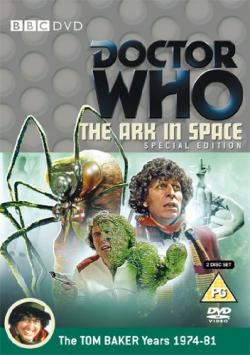
The Ark In Space
Written by Robert Holmes
Directed by Rodney Bennett
Broadcast on BBC1: 25 Jan - 15 Feb 1975
DVD release: 25 Feb(R2), 12 Mar(R1)
After a spate of stories of which I have no real memory, this month finally returns to a period that I can firmly recall from a more youthful time of life. Having become an an avid viewer (translation: my parents were allowing me to watch now), the coming months were to bring great excitement: Sontarans! (remember those last year), Daleks! (remember those last year, too!), and Cybermen! (parents remember those with a Doctor that wasn't Jon Pertwee and assure me they'd be scary too ...). But, after a fun romp with a giant Robot and Sarah being stuck on a roof, this week we were off to a strange Space Station orbiting the Earth ...
The Ark In Space is the adventure that heralds what many of my age think of as the "golden age" of Doctor Who, a period when Philip Hinchcliffe and Robert Holmes ruled the show and brought us some of the greatest adventures encountered by the Doctor, accompanied by his best friend (and our favourite companion) Sarah Jane Smith. Though Hinchcliffe and Holmes had inherited the initial set of scripts from their predecessors Barry Letts and Terrance Dicks, the falling through of the original storyline by John Lucarotti enabled them to launch their tenure with the kind of story they'd like to tell. And boy were they to do so ...
After a teaser of a strange glowing green thingy apparently attacking its sleeping victim, our heroes arrive some time later to discover an apparently lifeless station. First they have to deal with the lack of air, then a door sealing Sarah off from the others, then a re-activated security system intent on wiping about anything organic it can set its sights on; after that, Sarah has been transmatted off somewhere and the Doctor and Harry have to track her down, whereupon they finally find her amidst a huge "Ark" containing the survivors of the human race.
That, in essence, is episode one, which by description alone might not sound too exciting, but what really brings it to life is the already apparent familiarity and comfortable rapport that the lead actors have together. It isn't often that an episode has just the principal cast performing (computer voices excepted) and be able to pull it off over some twenty-five minutes, but this episode manages just that. It sparkles with clever and witty dialogue, from the repartee between the Doctor and Harry as they undertake each challenge through to the Doctor's soliloquy on homo sapiens. And then there's the surprise cliffhanger as Harry opens a cupboard and a huge monster leaps upon him ...
... okay, so actually it's a dead wirrn and it's simply falling on him, but that wasn't quite so important to this infant!
Putting my adult fan head back on again, if anything with hindsight it is the realisation of the "monster of the week" that lets the story down slightly. The slight glimpse of the larva in the corridor is okay, but its more prominent appearance in later episodes shows just how reliant on bubblewrap it is. The adult wirrn also looks too much like fibreglass in the harsh studio light (something Hinchcliffe laments in the commentary) - plus, the initial stages of Noah's transformation does look a lot like he's simply put a glove on. However, it is the characters' reactions that help sell the threat, and Kenton Moore's rivetting performance as the tormented leader desperately trying to hold onto his own humanity is totally compelling and means his 'appendage' does not cause a distraction, nor do his subsequent appearances as the physical transformation continues apace throughout episode three - it's testament to this on how shocking it is for this episode's finale that we see Noah's tortured visage finally subsumed into the full wirrn form. Of course, the deficiencies apparent now meant nothing back then, and I can still recall how frightening these giant grasshoppers (as my mum called them) were. And, some 35 years later, the single staring eye out of the solar stack at the Doctor in episode two still sends a shiver up my spine!
Besides Noah, we have Vira, the Ark's First Medtech. On the documentary Wendy Williams explains how tricky it was to approach playing a really intelligent person, and on screen this comes across as a seeming aloofness much of the time - meaning that at the moments she does crack are really telling. However, I did think that perhaps the character should have been a little more emotional at the ultimate death of Noah (her bond partner). Out of the other characters that are brought out of cryogenic suspension, there is poor Libri (Christopher Masters) who barely gets to take his breath before he becomes the "possessed" Noah's first victim, Lycett (John Gregg) who gets smothered in bubblewrap - sorry a victim of a larva - but at least Rogin (Richardson Morgan) gets to nobly sacrifice his life to save the Doctor as the transport ship lifts off. To be honest, none of them really engaged me as much as the principal five stars, but Holmes still ensured that none of them were neglected, dialogue-wise.
There are some superb sets on display from designer Roger Murray-Leach (some of which to be seen again when the Doctor, Sarah and Harry return to the space station some time before in Revenge of the Cybermen) - the cryogenic chambers themselves look fantastic (a special mention should be made for Jan Goram, Tina Roach, Barry Summerford, Peter Duke, Richard Archer, Sean Cooney, Roy Brent, Rick Carroll, Lyn Summer and Geoffrey Brighty, all of whom had to stand patiently in the pallets pretending to be frozen through long recording sessions!).
The DVD:
The special edition sees a new documentary covering the production of the story; A New Frontier delves into the making of The Ark in Space and the move into a whole new era of Doctor Who, with then-incoming producer Philip Hinchcliffe reflecting on the issues he had with the inherited scripts, as mentioned earlier. Director Rodney Bennett and designer Roger Murray-Leach discuss the production itself, with contributions from Wendy Williams and Kenton Moore - the latter explaining the fun of portraying a character disappearing under progressive layers of bubble wrap! Oh, and there's an appearance by an unexpected fan to look out for, too ...The new production notes written by Martin Wiggins provide the usual in-depth analysis of the story's development; if you want to know which recording of Handel's Concerto Grosso in B Flat Major was used during Sarah's preparation, the original badge colour of the decontamination chamber, which extra ended up in which pallet, what John Lucarotti's original episodic titles are, and how Douglas Adams fits into the grand scheme of things, here's the place to find out!
Doctor Forever! is a new feature to appear on successive(ish) DVDs, looking at how Doctor Who survived in its 'wilderness years'. The first here, Love and War, explores the literary adventures of the Seventh and then Eighth Doctor through Virgin Books (under Peter Darvill-Evans) and then BBC Books (under Steve Cole and Justin Richards). Narrated by Ayesha Antoine, there are contributions from a host of authors including Russell T Davies (who also talked about his novel Damaged Goods contained elements he'd then recycle for the television series), Paul Cornell (whose the only author to date to have a book translated to screen with Human Nature), and the An Adventure in Space and Time writer Mark Gatiss. An interesting summary of how these ranges kept Doctor Who alive until the series return in 2005, and some candid observations over the BBC's abrupt 'seizure' of the book franchise from Virgin in 1997 as well as how they eventually reached their own demise (and the (ahem) novel way the spares went to use in Eastern Europe orphanages ...).
As with Planet of the Spiders in 2011, the omnibus repeat of the story is included on the second disc, which at seventy minutes means pretty much an episode is lost in the condensed version. I must admit I skimmed this a bit (at 1.5x too), being I'd watched the full version recently, but it is interesting to see how some sections get excised along the way - I noticed the Doctor's speech about humanity in episode one had been lost, and little things like Noah initially shooting the Doctor in episode two and the High Minister's speech in episode three disappeared too.
Other new DVD features include the raw footage of Tom Baker's visits to Northern Ireland in Scene Around Six, the clips of which were rediscovered back in 2011, plus 8mm film of location filming for Robot and the PDF files of Radio Times listings and - for those of us who didn't buy every single tie-in merchandise in the mid-eighties - The Doctor Who Technical Manual (so I can finally build my own TARDIS!). Most of the original 2002 features have been carried across to the special edition, with the notable exception of the Wookey Hole interview with Tom Baker that was released again in its 'proper' place on Revenge of The Cybermen in 2010.
Random Observations:
- The "pink" title sequence present for this story is a fun anomaly (as are the other title sequence variants that are included as an extra)
- Unlike some of the commentaries to come, Tom Baker is quite serious on this one, though he still has time for his own style of random observations with comments such as "four jaunty buttocks"!
- It's interesting how the role of a women is played around with during the story, with Harry's blissfully ignorant inappropriate comment to Sarah about "the fairer sex being the top of the totem pole" contrasting against the Doctor's deliberate goading of Sarah's deficiencies to get her to move through the pipeline.
- I wonder if Begonia Pope ever heard that her alias was Madame Nostrodamus ...
- The Doctor's introduction of Harry's credentials as being "only qualified to work on sailors" is still amusing, though being it is also on the main menu loops of both discs perhaps it has worn out its welcome now...
- What with the sailor joke earlier in the script and Philip Hinchcliffe's observation of Robert Holmes having fun with the script, Harry then exclaiming "I found the Queen in the cupboard" caused an outbreak of uproarious laughter from both the commentary crew and myself!
- There's a strong theme of the fear of possession and loss of identity running through the story, with Noah's struggle against his physical transformation, the Doctor's mental struggle with the hive mind, and the lingering thought about what actually happened to the hapless Dune (Brian Jacobs) under the Queen's ministrations ...
- The way in which the wirrn propogate through 'contagion' is a theme that rears its head again a year later with the Krynoid's reproductive cycle in The Seeds of Doom.
- It's a shame that the cut scene of Noah's plea for Vira to kill him no longer exists - it might have been a step too far for the audience in 1975 but it would have made a great deleted scene in 2013!
- The autobiography "All Friends Betrayed" by Judas Baker is something to look forward to (grin)
- And for those who always turn off before the end titles have finished ... well, you've missed out on a treat!
Conclusion:
All-in-all, the story is quite minimal in its presentation but very effective in its execution. Great acting, stunning sets and scintillating dialogue all competently meld together to create a compelling story, and though the creature realisation was perhaps not as effective as some past and future efforts, in combination with the other elements they form a memorable adversary.And as for the TARDIS team of Tom Baker, Elisabeth Sladen and Ian Marter, they are on fine form, and between them triumphantly launch this "golden age" of Doctor Who!

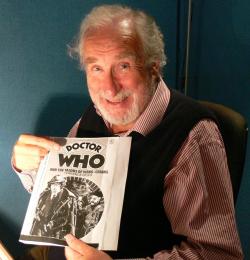
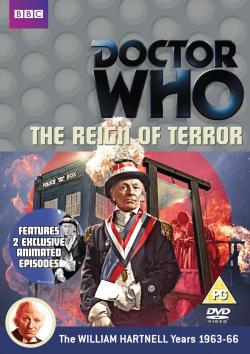
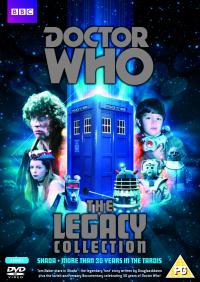 This review is based on a preview of the UK Region 2 DVD, which is
This review is based on a preview of the UK Region 2 DVD, which is 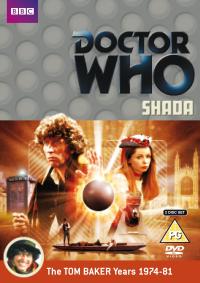 There are two versions of the story to choose from on the disc, the 'reconstruction' presentation of the original
There are two versions of the story to choose from on the disc, the 'reconstruction' presentation of the original 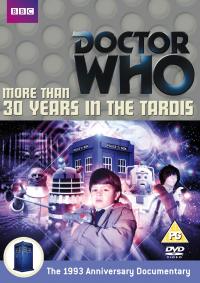 It is perhaps fitting that the 'definitive' celebration of Doctor Who in the 20th Century is on one of the final of the original releases in the Classic DVD range for the 21st - in many ways it the the forerunner of all we've come to enjoy about the range!
It is perhaps fitting that the 'definitive' celebration of Doctor Who in the 20th Century is on one of the final of the original releases in the Classic DVD range for the 21st - in many ways it the the forerunner of all we've come to enjoy about the range!






